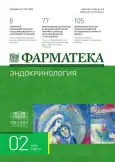Modern technologies in diabetes management
- Authors: Koteshkova O.M.1, Antsiferov M.B.1,2, Antsiferova D.M.1,2, Demidov N.A.3
-
Affiliations:
- Endocrinological Dispensary of the Moscow Healthcare Department
- Russian Medical Academy of Continuous Professional Education
- City Hospital of Moscow City of the Moscow Healthcare Department
- Issue: Vol 31, No 2 (2024)
- Pages: 41-48
- Section: Clinical experience
- Published: 23.05.2024
- URL: https://journals.eco-vector.com/2073-4034/article/view/632317
- DOI: https://doi.org/10.18565/pharmateca.2024.2.41-48
- ID: 632317
Cite item
Abstract
Objective. Evaluation of the modern means of glycemic monitoring using a mobile application that allows for more effective, including remote diabetes mellitus (DM) management.
Basic provisions. Diabetes control is impossible without self-monitoring by the patient, which remains relevant in modern conditions. Recommendations for the management of patients with diabetes are updated annually, more modern approaches to self-monitoring of glycemia are developed, and innovative glucometers represented by systems with a mobile application are introduced.
Full Text
About the authors
O. M. Koteshkova
Endocrinological Dispensary of the Moscow Healthcare Department
Author for correspondence.
Email: koala58@mail.ru
ORCID iD: 0000-0001-8428-4116
SPIN-code: 6141-1224
Cand. Sci. (Med.), Head of the Department of Education and Treatment of Diabetes
Russian Federation, MoscowM. B. Antsiferov
Endocrinological Dispensary of the Moscow Healthcare Department; Russian Medical Academy of Continuous Professional Education
Email: koala58@mail.ru
ORCID iD: 0000-0002-9944-2997
SPIN-code: 1035-4773
Russian Federation, Moscow; Moscow
D. M. Antsiferova
Endocrinological Dispensary of the Moscow Healthcare Department; Russian Medical Academy of Continuous Professional Education
Email: koala58@mail.ru
ORCID iD: 0000-0002-3920-5914
Russian Federation, Moscow; Moscow
N. A. Demidov
City Hospital of Moscow City of the Moscow Healthcare Department
Email: koala58@mail.ru
ORCID iD: 0000-0001-8289-0032
SPIN-code: 7715-4508
Russian Federation, Moscow
References
- www. diabetesatlas.org. Facts & figures (idf.org). URL: https://www.idf.org/aboutdiabetes/what-is-diabetes/facts-figures.html
- URL: https://iris.who.int/bitstream/handle/10665/374877/9789240084810-eng.pdf?sequence=1
- The Diabetes Control and Complications Trial Research Group. The effect of intensive treatment of diabetes on the development and progression of long-term complications in insulin-dependent diabetes mellitus. N Engl J Med. 1993;329:977–86. doi: 10.1056/NEJM199309303291401.
- Intensive blood-glucose control with sulphonylureas or insulin compared with conventional treatment and risk of complications in patients with type 2 diabetes (UKPDS 33). UK Prospective Diabetes Study (UKPDS) Group. Lancet. 1998;352:837–53.
- Алгоритмы специализированной медицинской помощи больным сахарным диабетом. Под ред. И.И. Дедова, М.В. Шестаковой, А.Ю. Майорова.11-е изд. М., 2023. [Algorithms for specialized medical care for patients with diabetes. Ed. by I.I. Dedov, M.V. Shestakova, A.Yu. Mayorov. 11th ed. Moscow, 2023. (In Russ.)]. doi: 10.14341/DM13042.
- Danne T., Nimri R., Battelino T., et al. International Consensus on Use of Continuous Glucose Monitoring. Diabetes Care. 2017;40:1631–40. doi: 10.2337/dc17-1600.
- Gagliardino J.J., Chantelot J.M., Domenger C., et al. Impact of diabetes education and self-management on the quality of care for people with type 1 diabetes mellitus in the Middle East (the International Diabetes Mellitus Practices Study, IDMPS). Diabetes Res Clin Pract. 2019;9(147):29–36. doi: 10.1016/j.diabres.2018.09.008.
- Grady M., Katz L.B., Cameron H., Levy B.L. Diabetes app-related text messages from health care professionals in conjunction with a new wireless glucose meter with a color range indicator improves glycemic control in patients with type 1 and type 2 diabetes: randomized controlled trial. JMIR Diabetes. 2017;2(2):e19 doi: 10.2196/diabetes.7454.
- Danne T., Nimri R., Battelino T., et al. International Consensus on Use of Continuous Glucose Monitoring. Diabetes Care. 2017;40:1631–40. doi: 10.2337/dc17-1600.
- Beck R. W., Bergenstal R.M., Cheng P., et al. The relationships between time in range, hyperglycemia metrics, and HbA1c. J Diabetes Sci Technol. 2019;13(4):614–26. doi: 10.1177/1932296818822496.
- Lu J., Ma X, Zhou J., et al. Association of time in range, as assessed by continuous glucose monitoring, with diabetic retinopathy in type 2 diabetes. Diabetes Care. 2018;41(11):2370–76. doi: 10.2337/dc18-1131.
- Lu J., Home P.D., Zhou J. Comparison of multiple cut points for time in range in relation to risk of abnormal carotid intima-media thickness and diabetic retinopathy. Diabetes Care. 2020;43:e99–e101. doi: 10.2337/dc20-0561.
- Yoo J.H., Kim J.H. Time in range from continuous glucose monitoring: a novel metric for glycemic control. Diabetes Metab J. 2020;44(6):828–39. doi: 10.4093/dmj.2020.0257.
- Ranjan A.G., Rosenlund S.V., Hansen T.W., et al. Improved time in range over 1 year is associated with reduced albuminuria in individuals with sensor-augmented insulin pump-treated type 1 diabetes. Diabetes Care. 2020;43(11):2882–2885. doi: 10.2337/dc20-0909.
- Yang J., Yang X., Zhao D., et al. Association of time in range, as assessed by continuous glucose monitoring, with painful diabetic polyneuropathy. J Diabetes Investig. 2021;12(5):828–36. doi: 10.1111/jdi.13394.
- Lu J., Wang C., Shen Y., et al. Time in Range in Relation to All-Cause and Cardiovascular Mortality in Patients With Type 2 Diabetes: A Prospective Cohort Study. Diabetes Care. 2021;44(2):549–55. doi: 10.2337/dc20-1862.
- Steinhubl S.R, Muse E.D., Topol E.J. Can mobile health technologies transform health care? JAMA. 2013;310(22):2395–96. doi: 10.1001/jama.2013.281078.
- Garabedian L.F, Ross-Degnan D., Wharam J.F. Mobile phone and smartphone technologies for diabetes care and self-management. Curr Diab Rep. 2015;15(12):109. doi: 10.1007/s11892-015-0680-8.
- Vaala S.E., Hood K.K., Laffel L., et al. Use of commonly available technologies for diabetes information and self-management among adolescents with type 1 diabetes and their parents: a web-based survey study. Interact J Med Res. 2015;4(4):e24. doi: 10.2196/ijmr.4504.
- Liang X., Wang Q., Yang X., et al. Effect of mobile phone intervention for diabetes on glycaemic control: a meta-analysis. Diabet Med. 2011;28(4):455–63. doi: 10.1111/j.1464-5491.2010.03180.x.
- Arambepola C., Ricci-Cabello I., Manikavasagam P., et al. The impact of automated brief messages promoting lifestyle changes delivered via mobile devices to people with type 2 diabetes: a systematic literature review and meta-analysis of controlled trials. J Med Internet Res. 2016;18(4):e86. doi: 10.2196/jmir.5425.
- Hsu W.C., Lau K.H.K., Huang R., et al. Utilization of a cloud-based diabetes management program for insulin initiation and titration enables collaborative decision making between healthcare providers and patients. Diabetes Technol Ther. 2016;18(2):59-67. doi: 10.1089/dia.2015.0160.
- Grady M., Cameron H., Holt Е. Sustained improvements in readings in-range using an advanced bluetooth® connected blood glucose meter and a mobile diabetes app: real-world evidence from more than 55,000 people with diabetes. Diabetes Ther. 2023;14(6):1023–35. doi: 10.1007/s13300-023-01415-3.
- Poster presented at Diabetes Technology Meeting (DTM) 2018; North Bethesda, Maryland Poster presented at Diabetes Technology Meeting (DTM) 2018; North Bethesda, Maryland.
Supplementary files









